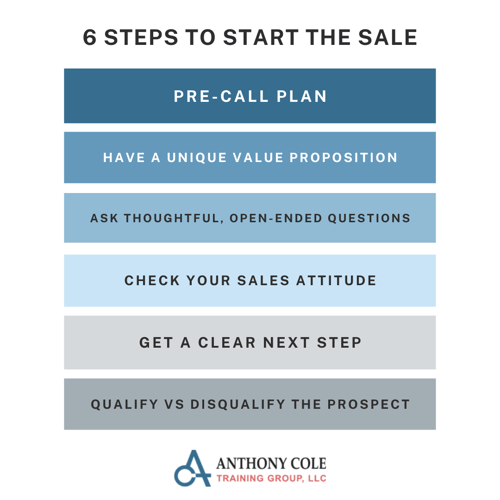The start of any undertaking is the most important step.
When it comes to building the confident and trusting relationship associated with a strong seller / buyer relationship, the start is especially important. I'm not just talking about the immediate "bonding and rapport" part of selling or a 5-minute segment of chitchat. The start I’m referring to is the entire first contact process whether it is a phone call or an association meeting or the initial meeting after the phone call. The start will often, if not always, determine your finish.
The 6 Steps to Start the Sale:
- Pre-Call Plan
- Have a Unique Value Proposition
- Ask Thoughtful, Open-Ended Questions
- Check Your Sales Attitude
- Get a Clear Next Step
- Qualify vs Disqualify the Prospect
- Be prepared (pre-call strategy). Be prepared for the sales process. Know what questions you are going to ask to move the sale forward. These are not questions about the technical aspects of your prospect's current position or status. Anticipate the suspect's answers to the questions you ask and be prepared with follow-up dialog. Too many sales people take this step for granted because "they've been in the business for __ years." Don’t fall into this trap. Also, be prepared for the inevitable curve balls the prospect will throw at you. This is your chance to build credibility.
- Demonstrate your credibility by what you say and by how you conduct yourself. You’re your value proposition different. Do this by the questions you ask, by your focus on the prospect and what is important to them, and by your reluctance to get into a sales pitch. Avoid doing the typical product dump. Demonstrate your knowledge of the industry by stories, analogies and metaphors that work to show you understand their business. Demonstrate your professionalism by the way you ask penetrating questions. Demonstrate your focus on their issues by not looking, acting or sounding like every other salesperson they have met.
- Have the courage to ask tough questions and have fierce/ honest discussions. You probably know the questions, but do you often leave an initial call having failed to ask:
- How will you make this decision?
- When do I meet the decision maker?
- If you don't have a budget, how will you pay for this?
- If you are shopping for low price, what happens if I show up and I'm not the low price?
- Who wins a tie?
- When you told your current provider that you were unhappy with the current situation, what did they say?
- When I show up to make my presentation, I need for you to be in a position to tell me 'yes' or 'no'. What objections do you have to that process?
- Check your sales attitude – the head stuff will drive your sales behaviors so leave your need for approval at the door when you leave the house in the morning. Re-write your personal beliefs about how and why people buy. Think about the impact of your personal buy cycle at the car lot where you debated for the last three weeks over which make/ model to purchase and where you haggled over price with the manager. Go out expecting people to buy.
- Qualify suspects / prospects to do business with you rather than the other way around. Don’t go to a meeting feeling like you must audition for the business. You don't. You shouldn’t. However, you should make sure that the person you are meeting with qualifies to do business with you. In an effective selling system, qualifying means the following:
- Does the prospect have a compelling reason to take action and when?
- Will they invest the time, money and resources to solve a problem they have or a problem they see coming? Will they invest that time, money or resources in a timely fashion or are they in the information collecting mode of buying?
- Will they tell you "yes" or "no" when you present? In order to accomplish this, you must have eliminated their current provider. You must have heard them say they want to fix it, whatever "it" is. And you must have a solution that is appropriate for their problem.
- Get a clear next step. There is always a next step even if you are in a "one appointment close" industry. It doesn't matter if your business requires multiple meetings or is typically "one and done". Always close per your identified objective for this meeting. Then move on. I promise you, that if you get masterful at this step, you will have fewer meetings and your closing ratio will improve. Ask for closure. Ask for a clear next step. Ask for the business Yes or No.
Master these 6 Steps to Start the Sale and you will close more business, more quickly, at higher margins.







